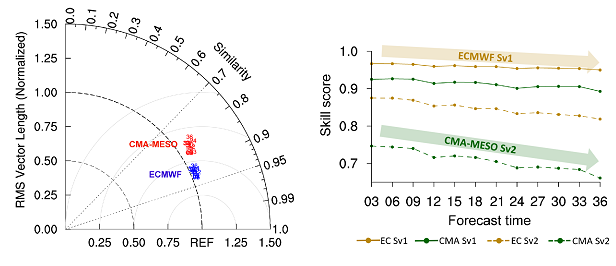Vector winds play a crucial role in triggering and maintaining convective weather, such as squall lines and typhoons, as well as the effective utilization of wind energy resources.
The mesoscale model of the China Meteorological Administration (CMA-MESO) and the highest-resolution model of the European Center for Medium Weather Forecasting (ECMWF) are widely used in weather forecasting. However, little attention has been paid to the ability of such models to simulate vector winds. Moreover, the modeled wind field is often divided into zonal and meridional wind, or wind speed and direction, which may lead to uncertainty when evaluating the forecast wind field.
In a recent study published in Atmospheric and Oceanic Science Letters, a team of Chinese scientists used a vector field evaluation method to assess the ability of the CMA-MESO and ECMWF models to forecast the vector wind fields in East China in 2022.
According to their findings, the ECMWF forecast is superior to that of the CMA-MESO model in predicting the spatial distribution and intensity of the vector wind field. Both models overestimate the wind speed over eastern China, but the CMA-MESO model overestimates it to a greater extent.
“The vector wind forecasting skill of the CMA-MESO and ECMWF models decreased with the length of forecasting time,” explains Dr. Fang Huang from Jiangsu Provincial Meteorological Service Center, China, the first author of the study. “And the prediction skill of the CMA-MESO model decreases faster and fluctuates more.”
To a certain extent, the variability of the wind field reflects fluctuations in the weather, and the fluctuations of wind fields will further affect the stability of wind power. Therefore, investigating wind field variability is of great significance.
With this in mind, the team also analyzed the vector wind field from the perspective of temporal variability. The spatial distribution of vector wind variability showed that of the ocean to be larger than that of the land, and that of the north to be larger than that of the south, with the CMA-MESO model overestimating the amplitude of vector wind variability.
“This may further increase the uncertainty in wind power prediction based on the model forecast”, adds Dr. Huang.
In summary, the researchers point out that evaluation of the wind field of numerical weather prediction models from the perspective of the vector field can provide a scientific basis for evaluating and improving the use of wind field forecast products.

Global vector wind field (source: https://svs.gsfc.nasa.gov/3829)

Vector field evaluation diagram and Sv1 and Sv2 skill scores of the vector wind field at lead times of 3–36 h in the CMA-MESO model and ECMWF model in East China in 2022.
Link:
https://doi.org/10.1016/j.aosl.2024.100559
Citation:
Fang Huang, Mingjian Zeng, Zhongfeng Xu, Boni Wang, Ming Sun, Hangcheng Ge, Shoukang Wu, 2024. Evaluating vector winds over eastern China in 2022 predicted by the CMA-MESO model and ECMWF forecast. Atmospheric and Oceanic Science Letters, https://doi.org/10.1016/j.aosl.2024.100559.
|